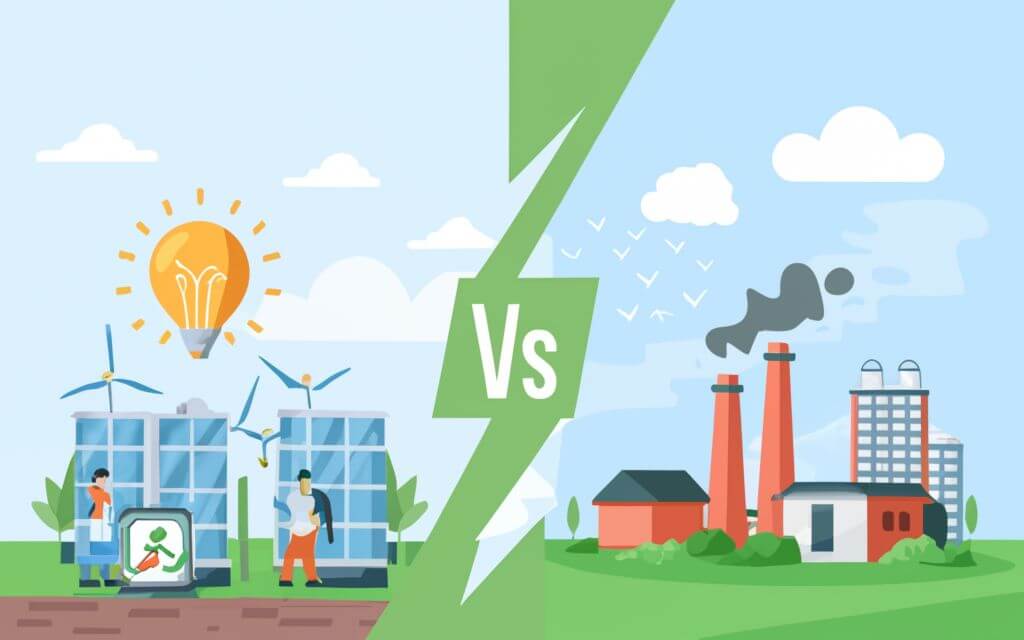The debate between non-renewable and renewable energy sources is a critical consideration in the current global discourse on energy. Non-renewable energy, mainly from limited resources, has been the primary source of power generation worldwide for a long time. However, environmental concerns and the recognition of the finite nature of these resources have led to a shift in focus towards renewable alternatives. Renewable energy is derived from sources that replenish naturally, making it an attractive solution to the challenges posed by non-renewable sources. This comparison of 21 key points will provide a detailed analysis of the complex dynamics of non-renewable and renewable energy sources, highlighting their environmental, economic, and societal impacts.

21 Points Comparison of Renewable and Nonrenewable Energy
- Source:
- Non-renewable Energy: Derived from finite resources such as fossil fuels (coal, oil, natural gas), uranium, and other non-renewable sources.
- Renewable Energy: Derived from sources that are continually replenished, such as sunlight, wind, geothermal, biomass, and hydropower.
- Availability:
- Non-renewable Energy: Limited and finite; once depleted, it cannot be replaced within a human lifetime.
- Renewable Energy: Virtually unlimited, as the sources are naturally replenished over time.
- Environmental Impact:
- Non-renewable Energy: Often associated with environmental degradation, air and water pollution, and greenhouse gas emissions leading to climate change.
- Renewable Energy: Generally has a lower environmental impact, with reduced emissions and pollution during energy production.
- Climate Change Contribution:
- Non-renewable Energy: Major contributor to climate change due to the release of carbon dioxide (CO2) and other greenhouse gases.
- Renewable Energy: Produces little to no greenhouse gas emissions during operation, contributing less to climate change.
- Energy Security:
- Non-renewable Energy: Susceptible to geopolitical conflicts and price fluctuations due to dependence on finite resources.
- Renewable Energy: Enhances energy security by diversifying sources and reducing dependence on geopolitically unstable regions.
- Energy Independence:
- Non-renewable Energy: Often relies on imports, affecting a nation’s energy independence.
- Renewable Energy: Can be produced locally, promoting energy independence.
- Resource Depletion:
- Non-renewable Energy: Resources are finite and deplete over time, increasing extraction challenges.
- Renewable Energy: Resources are sustainable, ensuring long-term availability without depletion concerns.
- Infrastructure Lifespan:
- Non-renewable Energy: Power plants and infrastructure have a limited lifespan and require frequent replacement or upgrades.
- Renewable Energy: Many renewable energy technologies have longer lifespans and require less frequent replacement.
- Economic Stability:
- Non-renewable Energy: Vulnerable to price fluctuations, geopolitical tensions, and supply disruptions.
- Renewable Energy: Offers more stable and predictable costs over the long term.
- Job Creation:
- Non-renewable Energy: Employment opportunities are often concentrated in specific regions and decline as resources deplete.
- Renewable Energy: Supports job creation across various regions, including manufacturing, installation, and maintenance.
- Land Use:
- Non-renewable Energy: Requires significant land for resource extraction, such as mining for coal or drilling for oil.
- Renewable Energy: Can utilize land for energy production (e.g., solar and wind farms) without resource extraction.
- Water Usage:
- Non-renewable Energy: Many traditional power plants require substantial water for cooling, potentially impacting local ecosystems.
- Renewable Energy: Generally has lower water requirements, reducing strain on water resources.
- Waste Generation:
- Non-renewable Energy: Produces various types of waste, including ash, sludge, and radioactive waste.
- Renewable Energy: Generates less waste during operation, and some technologies (e.g., solar panels) are recyclable.
- Technological Maturity:
- Non-renewable Energy: Established technologies with long histories of use.
- Renewable Energy: Rapid technological advancements, with some technologies still in the early stages of development.
- Energy Density:
- Non-renewable Energy: Often has higher energy density, providing more energy per unit of volume or mass.
- Renewable Energy: Variable energy density depending on the source, with some technologies less dense than fossil fuels.
- Reliability:
- Non-renewable Energy: Generally more consistent and reliable, with continuous power generation.
- Renewable Energy: Variable power generation depending on weather conditions (e.g., sunlight, wind), requiring energy storage solutions.
- Energy Storage Challenges:
- Non-renewable Energy: Less dependent on energy storage as the energy source is often readily available.
- Renewable Energy: It faces challenges in storing energy for use during periods of low renewable resource availability.
- Government Subsidies:
- Non-renewable Energy: Historically received subsidies, although there’s a shift towards renewable energy incentives.
- Renewable Energy: Often supported by government incentives and subsidies to promote adoption.
- Decentralization:
- Non-renewable Energy: Often centralized power generation and distribution systems.
- Renewable Energy: Allows decentralized energy production, empowering local communities and reducing transmission losses.
- Public Perception:
- Non-renewable Energy: Faces increasing scrutiny due to environmental concerns and climate change.
- Renewable Energy: Generally enjoys positive public perception for its environmental benefits.
- Future Viability:
- Non-renewable Energy: Faces challenges with resource depletion, environmental concerns, and the need to transition to sustainable alternatives.
- Renewable Energy is increasingly seen as the future of energy due to sustainability, environmental benefits, and technological advancements.
References:
- https://en.wikipedia.org/wiki/Renewable_energy
- https://en.wikipedia.org/wiki/Non-renewable_resource
- Related: Renewable Energy Sources
The comparison between non-renewable and renewable energy resources highlights the essential choices we must make to shape our future. Non-renewable sources are limited and have significant environmental consequences, while renewable energy is abundant and more environmentally friendly. However, the transition to renewables can be challenging due to issues such as intermittency and storage. We need to make a concerted effort to embrace renewable energy not only for environmental reasons but also for a sustainable future. This comparison serves as a roadmap for informed decision-making and emphasizes the urgency of moving towards a cleaner and more sustainable energy landscape.